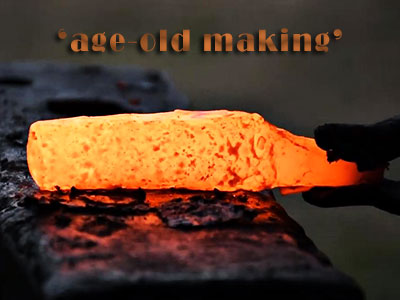Maintain Ur Kukri
Khukuri of the Month
Blade Size (in): 2.5 in (SUKx 1)
Weight (gm): 100
USD 17.99
Khukuri Handling
- Home
- Khukuri Handling
Khukuri carrying/using guide; Train yourself the right way...Tips and Techniques on How to Handle a Kukri Knife
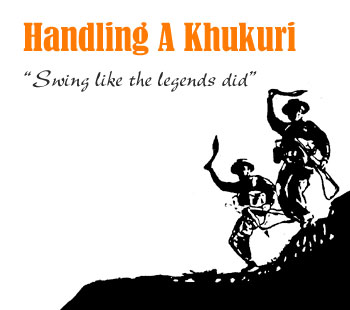
A khukuri /kukri is a basic and simple knife-cum-tool and requires no real skill or practice to use or handle. Even so, the objective of this page is to share some few simple techniques that will help you use this trusted tool more effectively and efficiently. We hope these methods will help/teach you to use the knife properly, after all, it's a sharp weapon that must be handled with care and respect.
[Learn how to use the kukri like the Gurkhas ... Swing like the legends and get maximum output. Holding, Carrying, Cutting, Drawing, Using Karda Chakmak, Swinging, Combat Encounter, Stabbing, and more...]
Khukuri Handling Catalog
- Carrying (Placement/Wearing)
- Drawing In and Out
- Holding - Normal (Basic)
- Holding - Thumbs up (Improvised)
- Swinging the Blade (Cutting)
- Combat/Encounter
- Stabbing
- Using Chakmak (small sharpener)
Carrying (Placement/Wearing)
 Side Waist Position:
Side Waist Position:
The most common and the easiest way is to carry a kukri at waist level on one side with edge or belly of the blade facing straight or slightly downward opposite side of the using hand.
 Front Waist Position / Sash carrying
Front Waist Position / Sash carrying
Different people carry kukri in different style or in whatever manner that benefits them or is comfortable. Typical village kukris don’t have belt loops since villagers or farmers don’t put on waist belts as they prefer to wear “Patuka or Sash” (a long cloth that goes around their waist circling it twice or thrice). Villagers use it to carry their kukris. They tuck it inside the Patuka facing downward at about a 60* parallel to land in stomach portion as shown in the picture. One hand holds the sheath firmly while the other hand slowly draws in-out the blade thru the handle. It is very easy to operate in this fashion.
 Back Carrying
Back Carrying
Soldiers on duty wear kukri on the right side of their belt. It is upright facing its belly straight back. Similarly, while on parade, the kukri is worn on the middle/center of the backside. The idea is to get both waist sides free so that hands can be swung and moved freely while performing. However, the drawing task is more difficult because of its placement. Normally a fast-draw (bit loose) kukri is preferred. Practice, hands, and body movement to accommodate the draw is crucial.
DRAWING IN AND OUT (taking in & out from Scabbard)
 Holding
Holding
Hold kukri firmly as shown in the picture with its edge/belly facing opposite to the body. The hand holding the scabbard should be at the back encircling it but without overlapping at the front portion of the scabbard. Do not encircle the front portion of the scabbard with your fingers while drawing kukri in and out as this may cause injury. Hold the upper edge of the scabbard with your palm and fingers as shown in the picture and then draw the weapon out slowly.
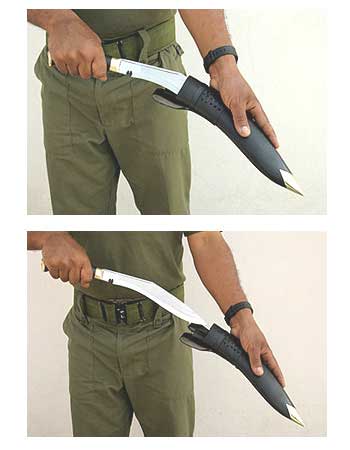 Drawing In and Out
Drawing In and Out
While drawing out the kukri, make sure that the spine of the blade is always touching the inner back surface of the scabbard. Same while inserting in and follow the curve of the scabbard until the whole blade goes into the scabbard.
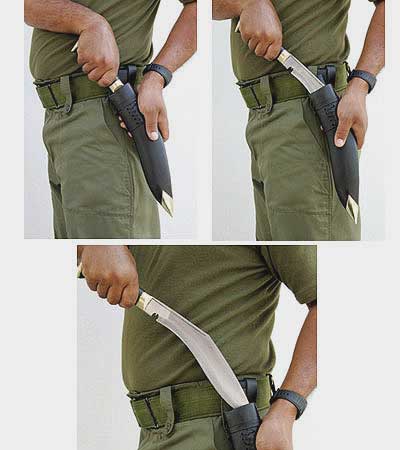 Drawing In/Out on Carrying Positions
Drawing In/Out on Carrying Positions
While drawing (incase of right-handed user), left hand should first hold the back side of the scabbard firmly by placing the palm around it and then the right hand should come into action; grip the handle firmly with closed fist around the handle and gently draw out the kukri. In this whole movement, user should make sure that his left hand that holds the scabbard is not overlapping the scabbard’s belly or front edge ( as the sharp kukri blade might cut through from inside and injure the crossing fingers). It is recommended to slightly turn/move the scabbard downward while drawing out for easier pulling.
 Locking (tighten)/ Loosen
Locking (tighten)/ Loosen
Sometimes scabbard may open up a little bit because of extensive use and become loose. In case like this after tucking the blade inside push the handle down against the edge of the scabbard. The kukri will get locked and tightened between the inner wooden walls of the scabbard.
Similarly, in case when a kukri is too tight to operate; put heavy oil on the both surface of the blade and tuck it inside the scabbard (forcefully if needed) then store it in a cool/cold dry place for few days. The leather gets stretched by doing this and will make more internal space for the kukri.
Holding a Khukuri
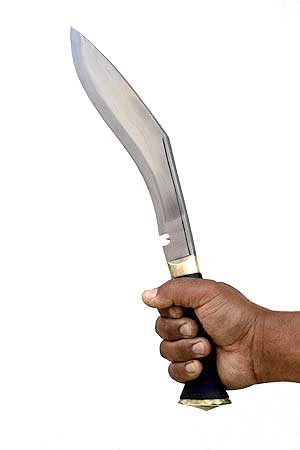 Holding - Normal (Basic)
Holding - Normal (Basic)
A basic and very simple fist position where the thumb extends/stays straight forward on top of index finger and closed-tight fist grip around the handle as shown in the picture. This position is recommended for use during combat, close encounter, exercise, and training.
 Holding - Thumbs up (Improvised)
Holding - Thumbs up (Improvised)
Here the thumb stays up slightly bent on the spine of the blade with the fist tightly closed around the handle. This position will give the pressure or force to throw or swing the blade against any surfaces. The thumb helps to maintain balance and also pushes the blade forward/downward making the work effective and tireless. This position is specially recommended for cutting, hacking, striking or performing any kinds of domestic, outdoor or jungle work when using a small or med size kukri blade (6" - 10").This grip is also very handy for slicing and peeling off an object. It is also advised that while using any kukri movement above the waist level, it should be held in the “Normal (Basic)” way, whereas, for movements below waist level the “Thumps Up” position is recommended.
Swinging the Blade
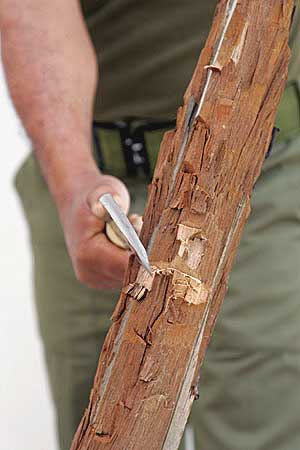

Swinging the Blade/ Cutting Angle
In order to get the desired result while swinging a kukri, it should be swung in a slightly angular movement making sure that the edge lands/hits the target angularly (at about 75º angle). Hitting the blade straight (90º angle) at the target should be avoided as it may pressurize the blade, rattling it and hence making cutting laborious and difficult. If the target is fix (cannot be positioned) then swing the blade angularly and if target can be positioned then position it angularly and swing the blade straight. Stand about a foot or two (or as needed) away from the object so that hands can be freely and forcefully swung. It is recommended to find a spot on the target and swing the blade in a rhythm-tic movement always aiming at the same spot. Hard balanced blows should be executed at the target however use of excessive force to achieve the goal quickly should be avoided. Rhythm, aim and consistency are the keys to effective swinging.
Fighting Techniques
Combat/Encounter
Grip, aim, and body position are very crucial. Targeting a point on the enemy's body is important. Proper body positioning and footwork will ensure a lethal and effective blow that can easily neutralize the enemy.

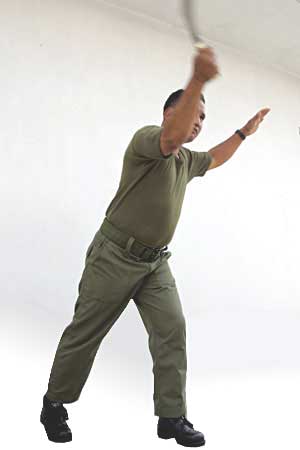
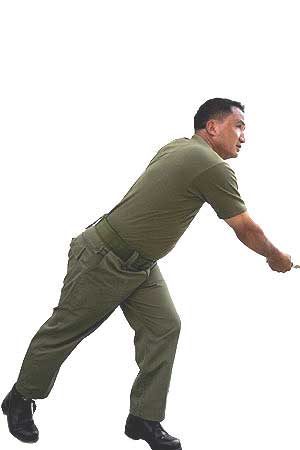
It is advised to position oneself at a more elevated level than the target by standing on the back foot’s toe. Stand slightly sideward to the target with feet stretched about 2 feet apart with the bodyweight resting on the back foot prior to striking. Before executing the stroke, keep the kukri-free hand stretched out aiming at the target, and the striking hand bent where the elbow is parallel to shoulder level. When releasing the stroke; the body should quickly lean towards the target transferring the body weight from back foot to the striking hand. Make sure that the hitting arm is well stretched out and the wrist flexible to meet the targeted point at about 45-75* angle. During the striking action, the free hand goes aside and back as the striking hand comes in full strength.
This movement will give a perfectly balanced action and thus a clean lethal blow with a fatal consequence.
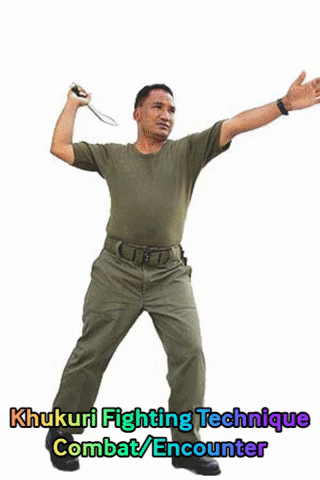
Stabbing with a kukri
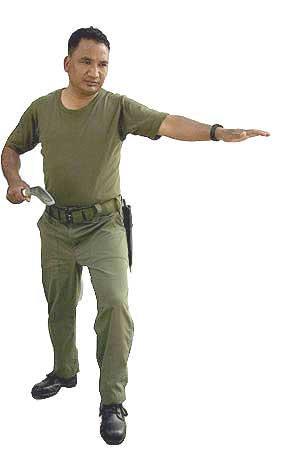 Stabbing
Stabbing
Stand sideward to the target with feet stretched apart, knee slightly bent. Pull the hand holding the kukri backward at about waist level, the free hand should be stretched out forward towards the targeted point prior to the stroke.
 Stabbing
Stabbing
When executing pull back the pointing free hand out of the way as the striking hand comes in.
 Stabbing
Stabbing
Move front foot further up while leaning towards the target to generate force/power and transfer the body weight from back foot to the front with back foot resting on sole. Move the kukri free hand at the back as the stroke comes in so that proper body balance can be maintained. Perfect timing and body movement are key to guarantee that stabbing is done swiftly and effectively.
 Stabbing
Stabbing
Move front foot further up while leaning towards the target to generate force/power and transfer the body weight from back foot to the front with back foot resting on sole. Move the kukri free hand at the back as the stroke comes in so that proper body balance can be maintained. Perfect timing and body movement are key to guarantee that stabbing is done swiftly and effectively.
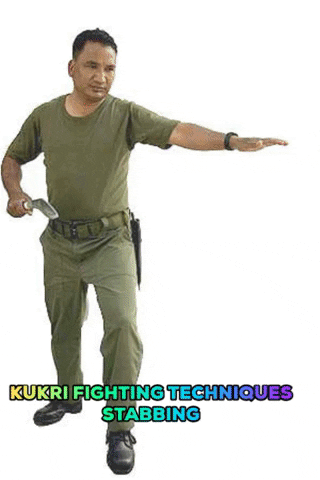
Using Chakmak
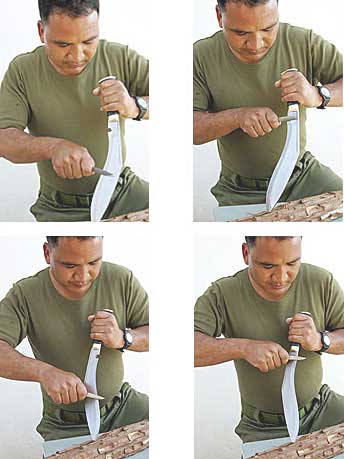 Chakmak (small sharpener and flint knife )
Chakmak (small sharpener and flint knife )
Almost all kukris come with these two small knives (Karda & Chakmak) on the back section (throat) of the scabbard. The “Karda” (one edge sharpened) is a small utility knife used to perform tasks that the big kukri blade cannot. The “Chakmak” (Both edge dull/unsharpened) is the sharpener used to sharpen both the main blade, and the small knife Karda.
To sharpen the kukri, place the blade firmly against a smooth leveled surface with the edge facing sideward by resting body weight on it as shown in the picture. Applying a little force, drag the Chakmak from the tip of the kukri to the notch (notch works as a stopper and prevents the Chakmak from going further up towards the handle) several times on one side. Make sure you maintain a certain rhythm and always start from tip to notch. Now flip the kukri to the other side and repeat the action. Repeat till you get the desired sharpness or edge.
The sharpening process with Chakmak is quite laborious and time-consuming. Therefore, a sharpening stone or designated sharpening hardware is recommended for faster and better results.
Kukri handling and technique shown here is for learning purpose and to better using and understanding the knife only. It is by NO means objected for any kind of violent purpose as a fighting knife or lethal tool. Kukri is more a domestic (creative) knife, for self defense and more as a historic weapon. KHHI nepal urges all people to use the knife with extreme care and caution with full responsibility and much respect.









